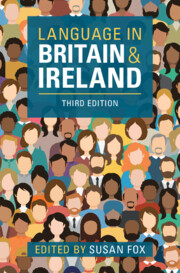Book contents
- Language in Britain and Ireland
- Language in Britain and Ireland
- Copyright page
- Contents
- Figures
- Tables
- Contributors
- Acknowledgements
- Map of Britain and Ireland
- Introduction
- Part I English
- 1 The History of English
- 2 Standard and Non-standard English
- 3 Phonetic and Phonological Variation in England
- 4 Grammatical Variation in England
- 5 Discourse-Pragmatic Variation in England
- 6 Scots and Scottish Standard English
- 7 English in Ireland
- 8 English in Wales
- 9 Insular Varieties of English in Britain
- 9 Insular Varieties of English in Britain
- 9 Insular Varieties of English in Britain
- 9 Insular Varieties of English in Britain
- Part II Multilingualism in Britain and Ireland: The Celtic Languages
- Part III Multilingualism in Britain and Ireland: Minority Languages
- Part IV Multilingualism: The Development of Urban Contact Varieties
- Part V Applied Sociolinguistic Issues
- Index
- References
5 - Discourse-Pragmatic Variation in England
from Part I - English
Published online by Cambridge University Press: 17 October 2024
- Language in Britain and Ireland
- Language in Britain and Ireland
- Copyright page
- Contents
- Figures
- Tables
- Contributors
- Acknowledgements
- Map of Britain and Ireland
- Introduction
- Part I English
- 1 The History of English
- 2 Standard and Non-standard English
- 3 Phonetic and Phonological Variation in England
- 4 Grammatical Variation in England
- 5 Discourse-Pragmatic Variation in England
- 6 Scots and Scottish Standard English
- 7 English in Ireland
- 8 English in Wales
- 9 Insular Varieties of English in Britain
- 9 Insular Varieties of English in Britain
- 9 Insular Varieties of English in Britain
- 9 Insular Varieties of English in Britain
- Part II Multilingualism in Britain and Ireland: The Celtic Languages
- Part III Multilingualism in Britain and Ireland: Minority Languages
- Part IV Multilingualism: The Development of Urban Contact Varieties
- Part V Applied Sociolinguistic Issues
- Index
- References
Summary
This chapter provides the first overview of regional variation in the frequency and sociolinguistic distribution of discourse-pragmatic items in England. We outline methodological and conceptual reasons for the historically limited knowledge of regional discourse-pragmatic variation, before addressing this gap by synthesising findings from individual research projects. We focus on comparing the distribution of selected discourse-pragmatic items from across different clause and utterance positions: general extenders, grammatically dependent negative-polarity question tags, invariant tags, focus markers, backchannel responses, attention signals, intensifiers, discourse like and quotatives. Notwithstanding acknowledged challenges in comparing results from individual studies, our overview reveals both striking cross-variety parallels in the distribution of these items, which we tentatively attribute to communicative factors, as well as robust patterns of regional variation, which we cautiously ascribe to regional socio-demographic differences that promote either linguistic conservatism or innovation.
Keywords
- Type
- Chapter
- Information
- Language in Britain and Ireland , pp. 128 - 150Publisher: Cambridge University PressPrint publication year: 2024

